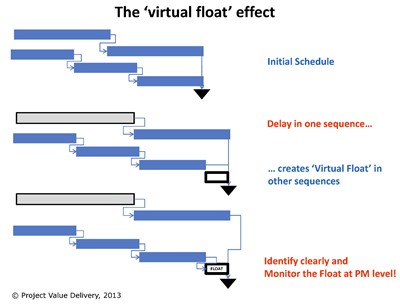Virtual Float is the bane of Project management. It appears when one sequence of activities gets delayed: virtual float, additional time is created in all other activity sequences. Project contributors then tend to use this additional time in their favor. This inevitably results in cost overruns and additional delay risks. It is essential for the Project Manager to make sure that additional float is created in Project sequences only under controlled conditions. In this essential White Paper 2016-07 ‘How to Fight the Fallacy of Virtual Float’ we describe a number of methods to identify and tame virtual float in Projects.
‘Virtual Float’ is bad. In some cases it would look like everybody is waiting for the first one to declare some delays so as to benefit from additional breathing space.
‘Virtual Float’ cannot be left unchecked and its utilization must remain under the control of the Project Manager. He needs to be able to decide whether it is appropriate to use it or not. The discipline of the Convergence Plan is here of much value, because it sets strict dates for the availability of key deliverables in the Project. Read our new White Paper 2016-07 ‘How to Fight the Fallacy of Virtual Float’ to fight the battle.
Find all these principles of Advanced Project Scheduling exposed in a comprehensive manner in our new Handbook,  Advanced Scheduling Handbook for Project Managers (now published – click on the link to see it on Amazon!)
Advanced Scheduling Handbook for Project Managers (now published – click on the link to see it on Amazon!)


